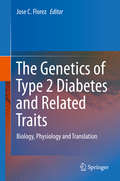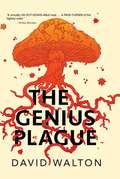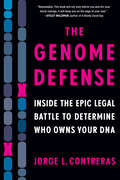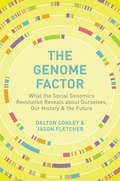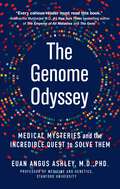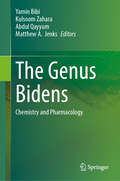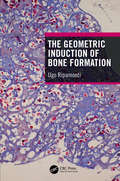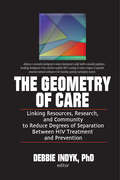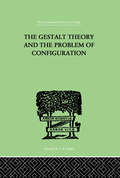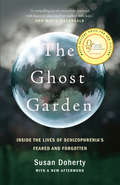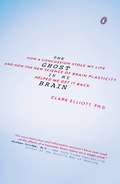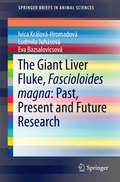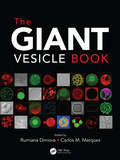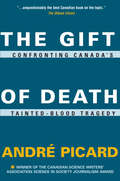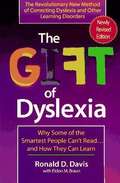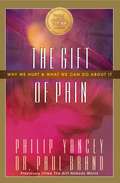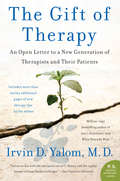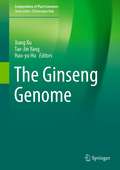- Table View
- List View
The Genetics of Type 2 Diabetes and Related Traits
by Jose C. FlorezThis book presents the state of the art of type 2 diabetes genetics, from the process of genetic discovery to its interpretation and clinical application, and illustrates a model for other complex human phenotypes. The first section explores genome-wide association studies, the extension of this method to less accessible phenotypes and the arrival of next-generation sequencing. A further section goes beyond genetics to illustrate how other data sources can help interpret genetic data, such as leveraging population diversity, the correlation of genetic associations with physiological measurements, gene expression modulation, environmental factors and our microbial commensals. The third section describes advances in elucidating the complex path from association to function using in-depth sequencing and functional studies of the cellular and molecular effects of genes in the loci identified by genetics. The final section links our current understanding with clinically relevant questions, such as prediction, interactions with drugs or nutrients, and disease prevention, and paints a realistic but hopeful vision of the future.
The Genius Life: Heal Your Mind, Strengthen Your Body, and Become Extraordinary (Genius Living #2)
by Max LugavereThe author of the New York Times bestselling Genius Foods is back with a lifestyle program for resetting your brain and body to its “factory settings,” to help fight fatigue, anxiety, and depression and to optimize cognitive health for a longer and healthier life.The human body was honed under conditions that no longer exist. The modern world has changed dramatically since our days as hunter gatherers, and it has caused widespread anxiety, stress, and disease, leaving our brains in despair. But science proves that the body and brain can be healed with the intervention of lifestyle protocols that help us to regain our cognitive birthright.In The Genius Life, Lugavere expands the Genius Foods plan, which focused on nutrition and how it affects brain health, and expands it to encompass a full lifestyle protocol. We know now that the health of our brains—including our cognitive function and emotional wellness—depend on the health of our gut, endocrine, cardiac and nervous systems as there is a constant feedback loop between all systems. Drawing on globe-spanning research into circadian biology, psychology, dementia prevention, cognitive optimization, and exercise physiology, The Genius Life shows how to integrate healthy choices in all aspects of our daily routines: eating, exercising, sleeping, detoxing, and more to create a healthy foundation for optimal cognitive health and performance. Among Max’s groundbreaking findings, you will discover:· A trick that gives you the equivalent of a “marathon” workout, in 10 minutes· How to get the benefits of an extra 1-2 servings of veggies daily without eating them· The hidden chemicals in your home that could be making you fat and sick· How to boost melatonin levels by up to 58% for deeper sleep without supplementsThe book features an achievable prescriptive 21-day plan for Genius Living that includes daily workouts, meal plans, and meal prep tips, and accompanied with helpful suggestions for healthy swaps and snacks
The Genius Plague
by David WaltonTHE CONTAGION IS IN YOUR MINDIn this science fiction thriller, brothers are pitted against each other as a pandemic threatens to destabilize world governments by exerting a subtle mind control over survivors.Neil Johns has just started his dream job as a code breaker in the NSA when his brother, Paul, a mycologist, goes missing on a trip to collect samples in the Amazon jungle. Paul returns with a gap in his memory and a fungal infection that almost kills him. But once he recuperates, he has enhanced communication, memory, and pattern recognition. Meanwhile, something is happening in South America; others, like Paul, have also fallen ill and recovered with abilities they didn't have before. But that's not the only pattern--the survivors, from entire remote Brazilian tribes to American tourists, all seem to be working toward a common, and deadly, goal. Neil soon uncovers a secret and unexplained alliance between governments that have traditionally been enemies. Meanwhile Paul becomes increasingly secretive and erratic. Paul sees the fungus as the next stage of human evolution, while Neil is convinced that it is driving its human hosts to destruction. Brother must oppose brother on an increasingly fraught international stage, with the stakes: the free will of every human on earth. Can humanity use this force for good, or are we becoming the pawns of an utterly alien intelligence?
The Genome Defense: Inside the Epic Legal Battle to Determine Who Owns Your DNA
by Jorge L. ContrerasIn this riveting, behind-the-scenes courtroom drama, a brilliant legal team battles corporate greed and government overreach for our fundamental right to control our genes. When attorney Chris Hansen learned that the U.S. government was issuing patents for human genes to biotech companies, his first thought was, How can a corporation own what makes us who we are? Then he discovered that women were being charged exorbitant fees to test for hereditary breast and ovarian cancers, tests they desperately needed—all because Myriad Genetics had patented the famous BRCA genes. So he sued them. Jorge L. Contreras, one of the nation&’s foremost authorities on human genetics law, has devoted years to investigating the groundbreaking civil rights case known as AMP v. Myriad. In The Genome Defense Contreras gives us the view from inside as Hansen and his team of ACLU lawyers, along with a committed group of activists, scientists, and physicians, take their one-in-a-million case all the way to the U.S. Supreme Court. Contreras interviewed more than a hundred key players involved in all aspects of the case—from judges and policy makers to ethicists and genetic counselors, as well as cancer survivors and those whose lives would be impacted by the decision—expertly weaving together their stories into a fascinating narrative of this pivotal moment in history. The Genome Defense is a powerful and compelling story about how society must balance scientific discovery with corporate profits and the rights of all people.
The Genome Factor: What the Social Genomics Revolution Reveals about Ourselves, Our History, and the Future
by Dalton Conley Jason FletcherFor a century, social scientists have avoided genetics like the plague. But the nature-nurture wars are over. In the past decade, a small but intrepid group of economists, political scientists, and sociologists have harnessed the genomics revolution to paint a more complete picture of human social life than ever before. The Genome Factor describes the latest astonishing discoveries being made at the scientific frontier where genomics and the social sciences intersect.The Genome Factor reveals that there are real genetic differences by racial ancestry—but ones that don't conform to what we call black, white, or Latino. Genes explain a significant share of who gets ahead in society and who does not, but instead of giving rise to a genotocracy, genes often act as engines of mobility that counter social disadvantage. An increasing number of us are marrying partners with similar education levels as ourselves, but genetically speaking, humans are mixing it up more than ever before with respect to mating and reproduction. These are just a few of the many findings presented in this illuminating and entertaining book, which also tackles controversial topics such as genetically personalized education and the future of reproduction in a world where more and more of us are taking advantage of cheap genotyping services like 23andMe to find out what our genes may hold in store for ourselves and our children.The Genome Factor shows how genomics is transforming the social sciences—and how social scientists are integrating both nature and nurture into a unified, comprehensive understanding of human behavior at both the individual and society-wide levels.
The Genome Odyssey: Medical Mysteries and the Incredible Quest to Solve Them
by Dr. Euan Angus AshleyIn The Genome Odyssey, Dr. Euan Ashley, Stanford professor of medicine and genetics, brings the breakthroughs of precision medicine to vivid life through the real diagnostic journeys of his patients and the tireless efforts of his fellow doctors and scientists as they hunt to prevent, predict, and beat disease.Since the Human Genome Project was completed in 2003, the price of genome sequencing has dropped at a staggering rate. It’s as if the price of a Ferrari went from $350,000 to a mere forty cents. Through breakthroughs made by Dr. Ashley’s team at Stanford and other dedicated groups around the world, analyzing the human genome has decreased from a heroic multibillion dollar effort to a single clinical test costing less than $1,000. For the first time we have within our grasp the ability to predict our genetic future, to diagnose and prevent disease before it begins, and to decode what it really means to be human.In The Genome Odyssey, Dr. Ashley details the medicine behind genome sequencing with clarity and accessibility. More than that, with passion for his subject and compassion for his patients, he introduces readers to the dynamic group of researchers and doctor detectives who hunt for answers, and to the pioneering patients who open up their lives to the medical community during their search for diagnoses and cures. He describes how he led the team that was the first to analyze and interpret a complete human genome, how they broke genome speed records to diagnose and treat a newborn baby girl whose heart stopped five times on the first day of her life, and how they found a boy with tumors growing inside his heart and traced the cause to a missing piece of his genome.These patients inspire Dr. Ashley and his team as they work to expand the boundaries of our medical capabilities and to envision a future where genome sequencing is available for all, where medicine can be tailored to treat specific diseases and to decode pathogens like viruses at the genomic level, and where our medical system as we know it has been completely revolutionized.
The Genus Bidens: Chemistry and Pharmacology
by Matthew A. Jenks Abdul Qayyum Yamin Bibi Kulsoom ZaharaThis contributed volume on phytochemistry and pharmacology of the genus Bidens covers the chemical constituents and biological activities of this plant group in detail. Bidens is an important genus of the Asteraceae family, which is one of the dominant plant families globally, contributing medicinal species. It is a diverse genus of weedy herbs with roughly 230 species. Members of this genus have been listed in Oriental Materia Medica as remedies for rheumatoid arthritis, sprains, insect and scorpion stings, diarrhea, dysentery, hepatitis, acute nephritis, stomachaches, and sore throats. Despite its medicinal properties, the chemistry and pharmacology of this genus are disorganized. The aim of this book is to present comprehensive information on the chemical constituents, nutraceutical and ethnomedical uses, as well as the biological and pharmacological effects and toxicity of this plant, based on 218 literary sources reported over 40 years. Major chemical constituents (including 301 compounds) belonging to polyacetylenes, polyacetylene glycosides, flavonoids, flavone glycosides, aurones, chalcones, okanin glycosides, phenolic acids, terpenes, pheophytins, fatty acids, and phytosterols have been identified or isolated from different parts of this plant. Many of them are considered bioactive compounds potentially responsible for pharmacological actions. The book will appeal to a wide range of readers, including researchers, botanists, and students studying the phytochemistry and pharmacology of medicinal plants. It may also interest pharmaceutical companies seeking to develop new drugs based on the chemical constituents of Bidens.
The Geographies of COVID-19: Geospatial Stories of a Global Pandemic (Global Perspectives on Health Geography)
by Melinda Laituri Robert B. Richardson Junghwan KimThis volume of case studies focuses on the geographies of COVID-19 around the world. These geographies are located in both time and space concentrating on both first- and second-order impacts of the COVID-19 pandemic. First-order impacts are those associated with the immediate response to the pandemic that include tracking number of deaths and cases, testing, access to hospitals, impacts on essential workers, searching for the origins of the virus and preventive treatments such as vaccines and contact tracing. Second-order impacts are the result of actions, practices, and policies in response to the spread of the virus, with longer-term effects on food security, access to health services, loss of livelihoods, evictions, and migration. Further, the COVID-19 pandemic will be prolonged due to the onset of variants as well as setting the stage for similar future events. This volume provides a synopsis of how geography and geospatial approaches are used to understand this event and the emerging “new normal.” The volume's approach is necessarily selective due to the global reach of the pandemic and the broad sweep of second-order impacts where important issues may be left out. However, the book is envisioned as the prelude to an extended conversation about adaptation to complex circumstances using geospatial tools.Using case studies and examples of geospatial analyses, this volume adopts a geographic lens to highlight the differences and commonalities across space and time where fundamental inequities are exposed, the governmental response is varied, and outcomes remain uncertain. This moment of global collective experience starkly reveals how inequality is ubiquitous and vulnerable populations – those unable to access basic needs – are increasing. This place-based approach identifies how geospatial analyses and resulting maps depict the pandemic as it ebbs and flows across the globe. Data-driven decision making is needed as we navigate the pandemic and determine ways to address future such events to enable local and regional governments in prioritizing limited resources to mitigate the long-term consequences of COVID-19.
The Geometric Induction of Bone Formation
by Ugo RipamontiThe Geometric Induction of Bone Formation describes new biomimetic biomaterials that offer mechanistic osteogenic surfaces for the autonomous and spontaneous induction of bone formation without the addition of osteogenic soluble molecular signals of the transforming growth factor-β supergene family. The chapters frame our understanding of regenerative medicine in primate species, including humans. The goal is to unravel the fundamental biological mechanisms of bone formation unique to non-human and human primates. The broad target audience dovetails with several disciplines both in the academic and private biotech sectors primarily involved in molecular biology, tissue biology, tissue engineering, biomaterial science, and reconstructive, orthopaedic, plastic, and dental surgery. Key Features Includes outstanding images of undecalcified whole mounted sections Summarizes non-human primate research – ideal for clinical translation Reviews methods for creating devices capable of making bone autonomously, i.e. an intrinsically osteo-inductive bioreactor and/or biomaterial Describes the spontaneous induction of bone formation including a whole spectrum of tissue biology, from basic molecular biology to clear-cut morphology and pre-clinical application in non-human primate species Intended for audiences in both academic research and the biotech industry
The Geometry of Care: Linking Resources, Research, and Community to Reduce Degrees of Separation Between HIV Treatment and (Social Work In Health Care Ser.)
by Gary Rosenberg Andrew Weissman Debbie IndykConnect multiple resources to form effective strategies to deal with AIDSAn effective strategy to deal with the AIDS epidemic is to have a wide range of scientists, clinicians, front-line workers, and clients distribute theory, care, and resource knowledge geometrically through all levels. The Geometry of Care: Linking Resources, Research, and Community to Reduce Degrees of Separation Between HIV Treatment and Prevention shows how to link bottom-up and top-down approaches to advance care, services, resources, training, theory, and policy analysis. Leading authorities draw upon behavioral and organizational theory to discuss the development of the frameworks necessary to effectively disseminate knowledge to benefit those needing care and to protect the community from further risk.The Geometry of Care builds a powerful case for the development of sustained links among academic resources and the community. Practical strategies are provided to set up a dynamic response framework to integrate the latest advances in treatment and prevention. The first section focuses on System and Program Level Geometry, the second on Patient and Provider Level Geometry. This is the book that shows how to meet the challenge to effectively understand, diagnose, treat, and prevent AIDS simultaneously on multiple fronts.Topics in The Geometry of Care include: expanding strategic care to include patient, community, and medical centers the assessment, dissemination, and integration of new advances the bottom-up development of links among providers, systems, and settings increased communication through the network of generalists and specialists within hospitals examples of infrastructure building at a family health service, a medical center-based AIDS center, and a home-based ambulatory care program how sustained setting/site relationships help to foster customized interventions serving clients better by tracking them through data management integration of prevention and treatment for clients dealing with multiple co-morbidities forging links between Western and traditional medicine tailoring prevention strategies to fit the individual shifting the locus of care to the HIV-positive individual an inter-organizational approach to supporting patient-provider interaction understanding barriers to adherence HIV as a family disease-and the geometry of care as a family issue the need for partnership between patient and primary care provider individuals with HIV and their instrumental role in prevention and transmission much, much more!The Geometry of Care is a unique, horizon-expanding book that is perfect for community workers, community activists, public health professionals, HIV clinical providers, adherence specialists, applied sociologists, and other practitioners dedicated to finding ways to provide the best in care.
The Gestalt Theory And The Problem Of Configuration (International Library Of Psychology Ser.)
by Bruno PetermannThis is Volume VIII of a series of twenty-one on Cognitive Psychology. Originally published in 1932, this study looks at the problem of configuration and the Gestalt Theory, its empirical foundation and dynamics.
The Ghost Garden: Inside the lives of schizophrenia's feared and forgotten
by Susan DohertyA rare work of narrative non-fiction that illuminates a world most of us try not to see: the daily lives of the severely mentally ill, who are medicated, marginalized, locked away and shunned.Susan Doherty's groundbreaking book brings us a population of lost souls, ill-served by society, feared, shunted from locked wards to rooming houses to the streets to jail and back again. For the past ten years, some of the people who cycle in and out of the severely ill wards of the Douglas Institute in Montreal, have found a friend in Susan, who volunteers on the ward, and then follows her friends out into the world as they struggle to get through their days. With their full cooperation, she brings us their stories, which challenge the ways we think about people with mental illness on every page. The spine of the book is the life of Caroline Evans (not her real name), a woman in her early sixties whom Susan has known since she was a bright and sunny school girl. Caroline had formed a close friendship with Susan and shared stories from her life; through her, we experience what living with schizophrenia over time is really like. She has been through it all, including the way the justice system treats the severely mentally ill: at one point, she believed that she could save her roommate from the devil by pouring boiling water into her ear... Susan interleaves Caroline's story with vignettes about her other friends, human stories that reveal their hopes, their circumstances, their personalities, their humanity. She's found that if she can hang in through the first ten to fifteen minutes of every coffee date with someone in the grip of psychosis, then true communication results. Their "madness" is not otherworldly: instead it tells us something about how they're surviving their lives and what they've been through. The Ghost Garden is not only touching, but carries a cargo of compassion and empathy.
The Ghost in My Brain: How a Concussion Stole My Life and How the New Science of Brain Plasticity Helped Me Get it Back
by Clark ElliottThe dramatic story of one man's recovery offers new hope to those suffering from concussions and other brain traumas In 1999, Clark Elliott suffered a concussion when his car was rear-ended. Overnight his life changed from that of a rising professor with a research career in artificial intelligence to a humbled man struggling to get through a single day. At times he couldn't walk across a room, or even name his five children. Doctors told him he would never fully recover. After eight years, the cognitive demands of his job, and of being a single parent, finally became more than he could manage. As a result of one final effort to recover, he crossed paths with two brilliant Chicago-area research-clinicians--one an optometrist emphasizing neurodevelopmental techniques, the other a cognitive psychologist--working on the leading edge of brain plasticity. Within weeks the ghost of who he had been started to re-emerge. Remarkably, Elliott kept detailed notes throughout his experience, from the moment of impact to the final stages of his recovery, astounding documentation that is the basis of this fascinating book. The Ghost in My Brain gives hope to the millions who suffer from head injuries each year, and provides a unique and informative window into the world's most complex computational device: the human brain.From the Hardcover edition.
The Giant Liver Fluke, Fascioloides magna: Past, Present and Future Research
by Ivica Králová-Hromadová Ľudmila Juhásová Eva BazsalovicsováThis monograph presents complex data on Fascioloides magna from all aspects of its research (general information, distribution, spectrum of hosts) and summarizes the latest information on molecular structure of informative genes which were recently applied in resolving taxonomy and biogeography of this veterinary important parasite. The giant liver fluke, Fascioloides magna, is important liver parasite of free-living and domestic ruminants. Due to its biology, distribution, medical impact, and invasive character, this liver fluke attracts attention of wide spectrum of specialists - veterinary doctors, hunters and farmers, as well as scientists. The parasite utilizes wide range of free living and domestic ruminants as definitive hosts, with various pathological impacts ranging from moderate infections towards lethal effects. Fascioloides magna is of North American origin where it occurs in five enzootic regions. It was introduced to Europe along with its deer hosts in 19th century and it has established three permanent natural foci. The giant liver fluke represents an outstanding model for studying the origin, spatial distribution, migratory routs, and invasion processes of introduced species.
The Giant Vesicle Book
by Rumiana Dimova Carlos MarquesGiant vesicles are widely used as a model membrane system, both for basic biological systems and for their promising applications in the development of smart materials and cell mimetics, as well as in driving new technologies in synthetic biology and for the cosmetics and pharmaceutical industry. The reader is guided to use giant vesicles, from the formation of simple membrane platforms to advanced membrane and cell system models. It also includes fundamentals for understanding lipid or polymer membrane structure, properties and behavior. Every chapter includes ideas for further applications and discussions on the implications of the observed phenomena towards understanding membrane-related processes. The Giant Vesicle Book is meant to be a road companion, a trusted guide for those making their first steps in this field as well as a source of information required by experts. Key Features • A complete summary of the field, covering fundamental concepts, practical methods, core theory, and the most promising applications • A start-up package of theoretical and experimental information for newcomers in the field • Extensive protocols for establishing the required preparations and assays • Tips and instructions for carefully performing and interpreting measurements with giant vesicles or for observing them, including pitfalls • Approaches developed for investigating giant vesicles as well as brief overviews of previous studies implementing the described techniques • Handy tables with data and structures for ready reference
The Gift You Give Yourself: Surgical and Other Choices That Enhance Your Appearance, Confidence, and Health
by E. Gaylon McColloughAn experienced cosmetic surgeon details surgical and holistic options to help readers achieve their ideal look.In a society driven by appearances, we all know the importance of looking our best. The cosmetic industry is overflowing with procedures, products, and plans that promise to help us achieve this goal. But true health, success, and confidence are more than skin deep. How can you determine which options are best for you?In The Gift You Give Yourself, Dr. E. Gaylon McCollough invites readers to become more informed and better prepared to develop a life plan personalized to their own goals. With more than three decades of experience in facial plastic surgery and Rejuvenology™, he not only reveals the secrets of plastic surgery but also explores how diet and nutrition, skin care, and understanding the mind/body connection can keep you feeling and looking your best for longer than you might have thought possible. Dr. McCollough’s highly successful holistic approach will leave you ready to embark on the journey to becoming—and remaining—the you of your dreams.Praise for The Gift You Give Yourself“Anybody who is thinking of having any procedure should read The Gift You Give Yourself.” —Paul Nassif, MD, star of TV’s Botched“I enjoyed the honesty of Dr. McCollough . . . he goes into every detail about why your body might be appearing to age quicker than others, and many times it is because of a vitamin deficiency. I like that he discusses surgical and non-surgical choices and lifestyles for even the average person to feel and look beautiful.” —San Francisco Book Review
The Gift of Death: Confronting Canada's Tainted Blood Tragedy
by André PicardFew Canadians know of "Mr. L," an auto worker in Ontario who gave "the gift of life" in 1984 as part of a company blood donor drive. Many more will remember Kenneth Pittman, a 53-year-old heart patient, who died after being infected with AIDS -- from Mr. L's blood. They will also remember Mr. Pittman's wife, Rochelle, who contracted the virus from her husband because his doctor decided not to inform them of Mr. Pittman's fatal disease.This tragic story is a microcosm of Canada's blood scandal. For over a decade, bureaucratic dithering, profits-over-protection responses, a paternalistic medical establishment and uninformed victims combined to create the worst health-care disaster in Canadian history. More than 1,200 people have contracted AIDS from tainted blood -- and the dying continues.André Picard has produced the definitive analysis of this complex tragedy. All of the players are here -- public health officials who refused to take the "homosexual plague" seriously; the Red Cross, which worried about bad publicity and the bottom line; the too-little-too-late government that offered inadequate compensation for victims; and the arrogant medical establishment which sometimes took years to inform HIV patients of their condition; and most of all, the victims, who are paying for this betrayal with their lives.The Gift of Death is a call for a serious re-evaluation of an outdated blood system to ensure that a similar tragedy never occurs.
The Gift of Dyslexia: Why Some of the Smartest People Can't Read and How They Can Learn
by Ronald D. Davis Eldon M. BraunDavis shares the startling discovery he made which helped him overcome his own dyslexia, and reveals how dyslexia may be linked to uncommonly high levels of intelligence, creativity, and imagination.
The Gift of Pain: Why We Hurt and What We Can Do About It
by Philip Yancey Paul BrandA WORLD WITHOUT PAIN? Can such a place exist? It not only can--it does. But it's no utopia. It's a colony for leprosy patients: a world where people literally feel no pain, and reap horrifying consequences. His work with leprosy patients in India and the United States convinced Dr. Paul Brand that pain truly is one of God's great gifts to us. In this inspiring story of his fifty-year career as a healer, Dr. Brand probes the mystery of pain and reveals its importance. As an indicator that lets us know something is wrong, pain has a value that becomes clearest in its absence. The Gift of Pain looks at what pain is and why we need it. Together, the renowned surgeon and award-winning writer Philip Yancey shed fresh light on a gift that none of us want and none of us can do without.
The Gift of Pets: Stories Only a Vet Could Tell
by Bruce R. CostonBruce R. Coston's first book, Ask the Animals, earned him high praise for being another James Herriot. Now, in his delightful second memoir, Coston shares more rich stories about his animal patients and the clients who make veterinary practice so fulfilling. In this humorous, poignant, and enthralling collection, Coston explores what it is about the interaction with our pets that provides such profound companionship, and how a love for animals helps us to be more fully human. This ability to enrich and fulfill us is the Gift of pets.Coston's characters, both the people and the animals, will engage you from the first page. You'll meet Mr. Johnston, the linguist, and his Mountain of Love; Rachel, the office prankster; Coston's "girlfriend," Megan; and Mischief, the only patient Coston has ever had that helped to pay for her own surgery. You'll learn what a "sugar glider" is and how to give one mouth-to-mouth resuscitation. You'll marvel at Lisa, Coston's first veterinary technician, and the courage that the Gift of pets gave her to reinvent herself and rekindle the dreams she thought she had squandered.The Gift of Pets celebrates what it's like to be truly blessed with a deep love and concern for the pets with which we surround ourselves. Coston invites all animal lovers to rejoice in that Gift with him in this inspiring book of true stories.
The Gift of Therapy: An Open Letter to a New Generation of Therapists and Their Patients
by Irvin YalomThe culmination of master psychiatrist Dr. Irvin D. Yalom's more than thirty-five years in clinical practice, The Gift of Therapy is a remarkable and essential guidebook that illustrates through real case studies how patients and therapists alike can get the most out of therapy. The bestselling author of Love's Executioner shares his uniquely fresh approach and the valuable insights he has gained--presented as eighty-five personal and provocative "tips for beginner therapists," including: Let the patient matter to you Acknowledge your errors Create a new therapy for each patient Do home visits (Almost) never make decisions for the patient Freud was not always wrong A book aimed at enriching the therapeutic process for a new generation of patients and counselors, Yalom's Gift of Therapy is an entertaining, informative, and insightful read for anyone with an interest in the subject.
The Ginseng Genome (Compendium of Plant Genomes)
by Jiang Xu Tae-Jin Yang Hao-Yu HuThis book represents the first comprehensive compilation of information on all aspects of the medicinal plant Panax ginseng, ranging from its botany to applied aspects in medicine and molecular breeding. In contributions by respected experts, it also discusses the genetic background and biochemical profile of this important medicinal plant. Ginsenoside biosynthesis and metabolic dynamics are also described in detail. Given its scope, the book offers a valuable guide for students, educators and scientists in academia and industry interested in medicinal plants and pharmacy.
The Girl With Nine Wigs: A Memoir
by Sophie van der Stap'It's Saturday and everything is different. No, I didn't go to the market this morning and I didn't have my usual coffee on Westerstraat. And no, I wasn't getting ready for a new semester at college. Next Monday, January 31st, I have to admit myself at the hospital for my first chemotherapy session. For the next two months, I'm expected each week for a fresh shot of vincristine, etoposide, ifosfamide and loads more exciting abracadabra.'Sophie is twenty-one when she is diagnosed with a rare, aggressive form of cancer. A striking, fun-loving student, her world is reduced overnight to the sterile confines of a hospital. But within these walls Sophie discovers a whole new world of white coats, gossiping nurses, and sexy doctors; of shared rooms, hair loss, and eyebrow pencils.As wigs become a crucial part of Sophie's new life, she reclaims a sense of self-expression. Each of Sophie's nine wigs makes her feel stronger and gives her a distinct personality, and that is why each has its own name: Stella, Sue, Daisy, Blondie, Platina, Uma, Pam, Lydia, and Bebé. There's a bit of Sophie in all of them, and they reveal as much as they hide. Sophie is determined to be much more than a cancer patient.With refreshing candor and a keen eye for the absurd, Sophie van der Stap's The Girl With Nine Wigs makes you smile when you least expect it.
The Girl Without a Name (A Zoe Goldman novel #2)
by Sandra BlockIn what passes for an ordinary day in a psych ward, Dr. Zoe Goldman is stumped when a highly unusual case arrives. A young African American girl, found wandering the streets of Buffalo in a catatonic state, is brought in by police. No one has come forward to claim her, and all leads have been exhausted, so Zoe's treatment is the last hope to discover the girl's identity. When drugs prove ineffective and medical science seems to be failing, Zoe takes matters into her own hands to track down Jane Doe's family and piece together their checkered history. As she unearths their secrets, she finds that monsters hide where they are least expected. And now she must solve the mystery before it is too late. Because someone wants to make sure this young girl never remembers. The Girl Without a Name is a powerful novel of memory and forgetting, of unexpected friendship and understanding...and of the secrets we protect no matter the consequences.
The Girl with Nine Wigs: A Memoir
by Charlotte Caroline Jongejan Sophie van der StapA fun-loving student, Sophie is 21 when she is diagnosed with a rare, aggressive form of cancer. As she faces the challenges of chemotherapy, wigs become a crucial part of her self-expression. With refreshing honesty and a keen eye for the absurd, The Girl With Nine Wigs will make you smile when you least expect it.
